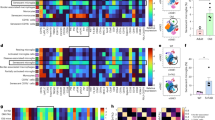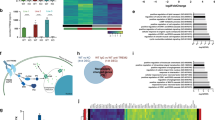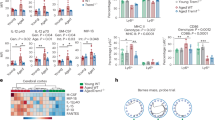Abstract
Triggering receptor expressed on myeloid cells 2 (TREM2) gene is a recently identified susceptibility gene for Alzheimer’s disease (AD), as its low-frequency variants increase the risk of this disease with an odds ratio similar to that of an APOE ɛ4 allele. To date, the expression and biologic functions of TREM2 under AD context remain largely unknown. Using APPswe/PS1dE9 mice, a transgenic model of AD, we showed that TREM2 was upregulated in microglia during disease progression. For the first time, we provided in vitro and in vivo evidence that this upregulation was attributed to the increased amyloid-β (Aβ)1–42 levels in the brain. By knockdown and overexpression of TREM2 in cultured primary microglia, we revealed that TREM2 modulated microglial functions under AD context, as it facilitated Aβ1–42 phagocytosis and inhibited Aβ1–42-triggered proinflammatory responses. Meanwhile, this modulation was dependent on DAP12, the adapter protein of TREM2. More importantly, overexpression of TREM2 in the brain of APPswe/PS1dE9 mice markedly ameliorated AD-related neuropathology including Aβ deposition, neuroinflammation, and neuronal and synaptic losses, which was accompanied by an improvement in spatial cognitive functions. Taken together, our data suggest that the upregulation of TREM2 serves as a compensatory response to Aβ1–42 and subsequently protects against AD progression by modulation of microglia functions. These findings provide insights into the role of TREM2 in AD pathogenesis, and highlight TREM2 as a potential therapeutic target for this disease.
Similar content being viewed by others
Log in or create a free account to read this content
Gain free access to this article, as well as selected content from this journal and more on nature.com
or
References
Adolfsson O, Pihlgren M, Toni N, Varisco Y, Buccarello AL, Antoniello K et al (2012). An effector-reduced anti-beta-amyloid (Abeta) antibody with unique abeta binding properties promotes neuroprotection and glial engulfment of Abeta. J Neurosci 32: 9677–9689.
Burgess N, Maguire EA, O'Keefe J (2002). The human hippocampus and spatial and episodic memory. Neuron 35: 625–641.
Calkins MJ, Reddy PH (2011). Amyloid beta impairs mitochondrial anterograde transport and degenerates synapses in Alzheimer's disease neurons. Biochim Biophys Acta 1812: 507–513.
Colonna M (2003). TREMs in the immune system and beyond. Nate Rev Immunol 3: 445–453.
Daws MR, Lanier LL, Seaman WE, Ryan JC (2001). Cloning and characterization of a novel mouse myeloid DAP12-associated receptor family. Eur J Immunol 31: 783–791.
Dodart JC, Marr RA, Koistinaho M, Gregersen BM, Malkani S, Verma IM et al (2005). Gene delivery of human apolipoprotein E alters brain Abeta burden in a mouse model of Alzheimer's disease. Proc Natl Acad Sci USA 102: 1211–1216.
Frank S, Burbach GJ, Bonin M, Walter M, Streit W, Bechmann I et al (2008). TREM2 is upregulated in amyloid plaque-associated microglia in aged APP23 transgenic mice. Glia 56: 1438–1447.
Gouras GK, Tampellini D, Takahashi RH, Capetillo-Zarate E (2010). Intraneuronal beta-amyloid accumulation and synapse pathology in Alzheimer’s disease. Acta Neuropathol 119: 523–541.
Griciuc A, Serrano-Pozo A, Parrado AR, Lesinski AN, Asselin CN, Mullin K et al (2013). Alzheimer's disease risk gene CD33 inhibits microglial uptake of amyloid beta. Neuron 78: 631–643.
Guerreiro R, Wojtas A, Bras J, Carrasquillo M, Rogaeva E, Majounie E et al (2013). TREM2 variants in Alzheimer's disease. N Engl J Med 368: 117–127.
Hamerman JA, Jarjoura JR, Humphrey MB, Nakamura MC, Seaman WE, Lanier LL (2006). Cutting edge: inhibition of TLR and FcR responses in macrophages by triggering receptor expressed on myeloid cells (TREM)-2 and DAP12. J Immunol 177: 2051–2055.
Hensley K (2010). Neuroinflammation in Alzheimer's disease: mechanisms, pathologic consequences, and potential for therapeutic manipulation. J Alzheimer's Dis 21: 1–14.
Hsieh CL, Koike M, Spusta SC, Niemi EC, Yenari M, Nakamura MC et al (2009). A role for TREM2 ligands in the phagocytosis of apoptotic neuronal cells by microglia. J Neurochem 109: 1144–1156.
Ito H, Hamerman JA (2012). TREM-2, triggering receptor expressed on myeloid cell-2, negatively regulates TLR responses in dendritic cells. Eur J Immunol 42: 176–185.
Jiang T, Yu JT, Zhu XC, Tan L (2013). TREM2 in Alzheimer's disease. Mol Neurobiol 48: 180–185.
Jiang T, Yu JT, Zhu XC, Tan MS, Gu LZ, Zhang YD et al (2014a). Triggering receptor expressed on myeloid cells 2 knockdown exacerbates aging-related neuroinflammation and cognitive deficiency in senescence-accelerated mouse prone 8 mice. Neurobiol Aging 35: 1243–1251.
Jiang T, Yu JT, Zhu XC, Tan MS, Wang HF, Cao L et al (2014b). Temsirolimus promotes autophagic clearance of amyloid-beta and provides protective effects in cellular and animal models of Alzheimer's disease. Pharmacol Res 81: 54–63.
Jin JJ, Kim HD, Maxwell JA, Li L, Fukuchi K (2008). Toll-like receptor 4-dependent upregulation of cytokines in a transgenic mouse model of Alzheimer's disease. J Neuroinflamm 5: 23.
Jonsson T, Stefansson H, Steinberg S, Jonsdottir I, Jonsson PV, Snaedal J et al (2013). Variant of TREM2 associated with the risk of Alzheimer's disease. N Engl J Med 368: 107–116.
Kapadia M, Sakic B (2011). Autoimmune and inflammatory mechanisms of CNS damage. Progr Neurobiol 95: 301–333.
Kiialainen A, Hovanes K, Paloneva J, Kopra O, Peltonen L (2005). Dap12 and Trem2, molecules involved in innate immunity and neurodegeneration, are co-expressed in the CNS. Neurobiol Dis 18: 314–322.
Larson ME, Lesne SE (2012). Soluble Abeta oligomer production and toxicity. J Neurochem 120 (Suppl 1): 125–139.
Liu S, Liu Y, Hao W, Wolf L, Kiliaan AJ, Penke B et al (2012). TLR2 is a primary receptor for Alzheimer's amyloid beta peptide to trigger neuroinflammatory activation. J Immunol 188: 1098–1107.
Meda L, Baron P, Scarlato G (2001). Glial activation in Alzheimer's disease: the role of Abeta and its associated proteins. Neurobiol Aging 22: 885–893.
Melchior B, Garcia AE, Hsiung BK, Lo KM, Doose JM, Thrash JC et al (2010). Dual induction of TREM2 and tolerance-related transcript, Tmem176b, in amyloid transgenic mice: implications for vaccine-based therapies for Alzheimer's disease. ASN Neuro 2: e00037.
Moreno-Gonzalez I, Estrada LD, Sanchez-Mejias E, Soto C (2013). Smoking exacerbates amyloid pathology in a mouse model of Alzheimer's disease. Nat Commun 4: 1495.
Neumann H, Daly MJ (2013). Variant TREM2 as risk factor for Alzheimer's disease. N Engl J Med 368: 182–184.
Neumann H, Takahashi K (2007). Essential role of the microglial triggering receptor expressed on myeloid cells-2 (TREM2) for central nervous tissue immune homeostasis. J Neuroimmunol 184: 92–99.
Paloneva J, Manninen T, Christman G, Hovanes K, Mandelin J, Adolfsson R et al (2002). Mutations in two genes encoding different subunits of a receptor signaling complex result in an identical disease phenotype. Am J Hum Genet 71: 656–662.
Paradowska-Gorycka A, Jurkowska M (2013). Structure, expression pattern and biological activity of molecular complex TREM-2/DAP12. Hum Immunol 74: 730–737.
Piccio L, Buonsanti C, Mariani M, Cella M, Gilfillan S, Cross AH et al (2007). Blockade of TREM-2 exacerbates experimental autoimmune encephalomyelitis. Eur JImmunol 37: 1290–1301.
Takahashi K, Prinz M, Stagi M, Chechneva O, Neumann H (2007). TREM2-transduced myeloid precursors mediate nervous tissue debris clearance and facilitate recovery in an animal model of multiple sclerosis. PLoS Med 4: e124.
Takahashi K, Rochford CD, Neumann H (2005). Clearance of apoptotic neurons without inflammation by microglial triggering receptor expressed on myeloid cells-2. J Exp Med 201: 647–657.
Tan MS, Yu JT, Jiang T, Zhu XC, Guan HS, Tan L (2014). IL12/23 p40 inhibition ameliorates Alzheimer's disease-associated neuropathology and spatial memory in SAMP8 mice. J Alzheimer's Dis 38: 633–646.
Turnbull IR, Gilfillan S, Cella M, Aoshi T, Miller M, Piccio L et al (2006). Cutting edge: TREM-2 attenuates macrophage activation. J Immunol 177: 3520–3524.
Varvel NH, Bhaskar K, Kounnas MZ, Wagner SL, Yang Y, Lamb BT et al (2009). NSAIDs prevent, but do not reverse, neuronal cell cycle reentry in a mouse model of Alzheimer disease. J Clin Invest 119: 3692–3702.
Walsh DM, Selkoe DJ (2004). Deciphering the molecular basis of memory failure in Alzheimer's disease. Neuron 44: 181–193.
Wyss-Coray T (2006). Inflammation in Alzheimer disease: driving force, bystander or beneficial response? Nat Med 12: 1005–1015.
Yan Y, Wang C (2006). Abeta42 is more rigid than Abeta40 at the C terminus: implications for Abeta aggregation and toxicity. J Mol Biol 364: 853–862.
Acknowledgements
This work was supported by the grants from the National Natural Science Foundation of China (to LT (81171209, 81371406) and JTY (81000544, 81471309)), the grants from the Shandong Provincial Natural Science Foundation (to LT (ZR2011HZ001) and JTY (ZR2010HQ004)), the Medicine and Health Science Technology Development Project of Shandong Province (to LT (2011WSA02018) and JTY (2011WSA02020)), and the Innovation Project for Postgraduates of Jiangsu Province (to TJ (CXLX13_561)).
Author information
Authors and Affiliations
Corresponding authors
Additional information
Supplementary Information accompanies the paper on the Neuropsychopharmacology website
Rights and permissions
About this article
Cite this article
Jiang, T., Tan, L., Zhu, XC. et al. Upregulation of TREM2 Ameliorates Neuropathology and Rescues Spatial Cognitive Impairment in a Transgenic Mouse Model of Alzheimer’s Disease. Neuropsychopharmacol 39, 2949–2962 (2014). https://doi.org/10.1038/npp.2014.164
Received:
Revised:
Accepted:
Published:
Issue date:
DOI: https://doi.org/10.1038/npp.2014.164
This article is cited by
-
The Role of ERK1/2 Pathway in the Pathophysiology of Alzheimer’s Disease: An Overview and Update on New Developments
Cellular and Molecular Neurobiology (2023)
-
Nrf2 regulates the arginase 1+ microglia phenotype through the initiation of TREM2 transcription, ameliorating depression-like behavior in mice
Translational Psychiatry (2022)
-
Naturally-aged microglia exhibit phagocytic dysfunction accompanied by gene expression changes reflective of underlying neurologic disease
Scientific Reports (2022)
-
Dynamic insights into the effects of nonsynonymous polymorphisms (nsSNPs) on loss of TREM2 function
Scientific Reports (2022)
-
Pon1 Deficiency Promotes Trem2 Pathway–Mediated Microglial Phagocytosis and Inhibits Pro-inflammatory Cytokines Release In Vitro and In Vivo
Molecular Neurobiology (2022)



